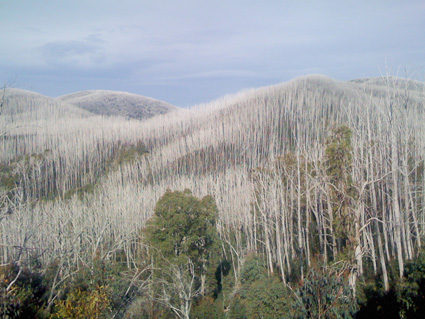An area of alpine ash (Eucalyptus delegatensis) burnt and killed during the catastrophic fires in the Australian Alps in 2003
The pattern of bushfires in Australia is shaped by the rainfall that comes with the tropical summer monsoon, a research group has found.
The researchers, supported by the Australian Centre for Ecological Analysis and Synthesis (ACEAS), also discovered that there is a trade-off between the intensity of fires and their frequency, influenced by the type of vegetation that fuels the fires. In the monsoonal north, fires are frequent and not very intense because the major source of fuel is grass. In the eucalypt forests of the south, though, although the fires are much less frequent, they are more intense due to the fuel source, which is largely leaf litter.
The researchers were surprised by their findings because they were expecting to confirm the theory that links fire regimes (the pattern, frequency and intensity of fires in an area) to the amount of vegetation (or, more strictly, net primary production, biomass stored as plant growth or eaten by herbivores).
The principal investigator of the working group, Dr Brett Murphy, said the fire season showed a clear transition from winter in the north to summer in the south.
‘Our analysis also shows that the variation in Australian fire regimes is related much less to net primary productivity than the strong rainfall gradient from the north to the south of the country, driven primarily by the summer monsoon in the north and winter fronts in the south.’
The methods and map the research group came up with are important for two reasons. First, accurate descriptions of fire regimes will improve how we manage landscapes and communities during fire seasons, down to details such as town planning and emergency procedures. Second, it will improve modelling of the effects of climate change.
‘At the moment, predictions of how fires will behave are pretty inaccurate because for most fire regimes we just don’t have a lot of data about some of the variables and how they interact,’ Brett says.
‘And if we can’t predict fire regimes, and changes that occur as part of global climatic changes, we’re in a poor position to minimise the huge emotional, economic and environmental cost of fires such as Black Saturday, or earlier ones such as Ash Wednesday in 1983 and Black Friday in 1939.
‘We used existing data to draw maps to explore the interactions and trade-offs among the components of fire regimes, and by doing this we’ve been able to determine that there is a coherent pattern over the 20 fire regimes of Australia. Australia is an ideal model to explore the diversity and characteristics of fire regimes globally, because we have a lot of fire-prone vegetation and it inhabits a large number of climate zones.’
Despite Australia’s vegetation being characterised by the eucalypts, most of our fire regimes are characterised by grass as the fuel, even in the more open eucalypt forests. However, in the most densely populated parts of the country, down the eastern seaboard, and in the south-eastern and south-western corners of the continent, the fuel type is forest litter.
Brett said there were several striking patterns to Australia’s fire regimes.
‘We have this impression that most of our fires are infrequent, and extremely intense and destructive, because of the devastation wrought by wildfires in eucalypt forests near major population centres. But it’s not really so,’ Brett says.
Most fires burn at relatively low intensities: they are surface fires that are fuelled by grass or leaf litter. These fires also tend to occur frequently (for example about every five years in savanna woodlands), and the frequency keeps the fuel levels low. Fire is rare in acacia shrublands and arid areas characterised by drought-resistant plants. However, in the wet eucalypt forests of south-eastern and south-western Australia, which correspond with our major population centres, fires burn at extremely high intensity, although they don’t occur very often, with intervals of 20 years between fires typical.
The research team of fire and vegetation ecologists came together as a working group supported by ACEAS to investigate the geographical study of the occurrence of fires in Australia. The Journal of Biogeography will shortly publish a paper on the outcomes of the project. For more information email Brett Murphy.
Published in TERN e-Newsletter November 2012







